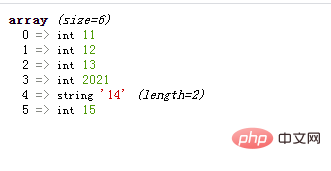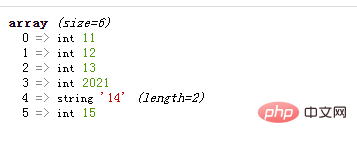 Backend Development
Backend Development
 PHP Problem
PHP Problem
 PHP array learning: extract digital elements and splice them into a new array
PHP array learning: extract digital elements and splice them into a new array
PHP array learning: extract digital elements and splice them into a new array
In the previous article, we introduced the method of emptying and deduplicating arrays, that is, deleting empty elements and duplicate elements in the array. If you are interested, you can click on the link to read → " How to remove blanks in PHP array learning Or repeated elements》. This time we continue the study and practice of PHP arrays and talk about how to filter arrays and extract numerical elements.
→Related recommendations: 《PHP array learning series summary (continuously updated~)》
The main content of today’s article is: Utilization PHP to filter the array, filter out the numeric elements (numeric values or numeric strings), and then combine them into a new array and return it.
Below we will introduce two implementation methods to you. First, we will start with the familiar method "foreach loop", and then introduce a method of filtering arrays using PHP's built-in functions.
Method 1: Use the foreach statement
1 2 3 4 5 6 7 8 9 |
|
Analyze the code:
Use the foreach statement to traverse the array, in each loop Assign the key value to
$value;Use the
is_numeric()function to detect$valueWhether it is a number or a string of numbers;If it is a number or a string of numbers, store
$valuein the$resultsarray .
In this way, all the numeric elements in the $results array are the numeric elements in the $array array. Using var_dump($result), the output result is:

Method 2: Using the array_filter() function
In the previous article, we already know that the array_filter() function can use a callback function To filter the elements in the array, the array elements will be passed to the callback function for processing.
Give the implementation code directly:
1 2 3 4 5 6 7 8 9 10 11 |
|
The output result is:

Let’s take a look at the array_filter() function
# The ##array_filter() function iterates through each value in the array and passes each key value to a user-defined function or callback function; if the callback function returns true, the current key value in the input array is returned to the result array ( The array key names remain unchanged). The syntax format is:1 |
|
- $array: array object, cannot be omitted.
function callbackfn ($value[, $key])
: Callback function, which can be omitted; if the callback function is omitted, null values will be filtered by default.- $mode: can be omitted, determines the parameter form received by the callback:
- ARRAY_FILTER_USE_KEY - callback accepts the key name as the only parameter
- ARRAY_FILTER_USE_BOTH - callback accepts both key name and key value
- The default value is 0, and only the value is passed as the only parameter of the callback callback.
- ARRAY_FILTER_USE_KEY - callback accepts the key name as the only parameter
PHP function array array function video explanation, come and learn!
The above is the detailed content of PHP array learning: extract digital elements and splice them into a new array. For more information, please follow other related articles on the PHP Chinese website!

Hot AI Tools

Undresser.AI Undress
AI-powered app for creating realistic nude photos

AI Clothes Remover
Online AI tool for removing clothes from photos.

Undress AI Tool
Undress images for free

Clothoff.io
AI clothes remover

Video Face Swap
Swap faces in any video effortlessly with our completely free AI face swap tool!

Hot Article

Hot Tools

Notepad++7.3.1
Easy-to-use and free code editor

SublimeText3 Chinese version
Chinese version, very easy to use

Zend Studio 13.0.1
Powerful PHP integrated development environment

Dreamweaver CS6
Visual web development tools

SublimeText3 Mac version
God-level code editing software (SublimeText3)

Hot Topics
 1663
1663
 14
14
 1420
1420
 52
52
 1315
1315
 25
25
 1266
1266
 29
29
 1239
1239
 24
24
 Explain JSON Web Tokens (JWT) and their use case in PHP APIs.
Apr 05, 2025 am 12:04 AM
Explain JSON Web Tokens (JWT) and their use case in PHP APIs.
Apr 05, 2025 am 12:04 AM
JWT is an open standard based on JSON, used to securely transmit information between parties, mainly for identity authentication and information exchange. 1. JWT consists of three parts: Header, Payload and Signature. 2. The working principle of JWT includes three steps: generating JWT, verifying JWT and parsing Payload. 3. When using JWT for authentication in PHP, JWT can be generated and verified, and user role and permission information can be included in advanced usage. 4. Common errors include signature verification failure, token expiration, and payload oversized. Debugging skills include using debugging tools and logging. 5. Performance optimization and best practices include using appropriate signature algorithms, setting validity periods reasonably,
 Explain late static binding in PHP (static::).
Apr 03, 2025 am 12:04 AM
Explain late static binding in PHP (static::).
Apr 03, 2025 am 12:04 AM
Static binding (static::) implements late static binding (LSB) in PHP, allowing calling classes to be referenced in static contexts rather than defining classes. 1) The parsing process is performed at runtime, 2) Look up the call class in the inheritance relationship, 3) It may bring performance overhead.
 PHP Program to Count Vowels in a String
Feb 07, 2025 pm 12:12 PM
PHP Program to Count Vowels in a String
Feb 07, 2025 pm 12:12 PM
A string is a sequence of characters, including letters, numbers, and symbols. This tutorial will learn how to calculate the number of vowels in a given string in PHP using different methods. The vowels in English are a, e, i, o, u, and they can be uppercase or lowercase. What is a vowel? Vowels are alphabetic characters that represent a specific pronunciation. There are five vowels in English, including uppercase and lowercase: a, e, i, o, u Example 1 Input: String = "Tutorialspoint" Output: 6 explain The vowels in the string "Tutorialspoint" are u, o, i, a, o, i. There are 6 yuan in total
 What are PHP magic methods (__construct, __destruct, __call, __get, __set, etc.) and provide use cases?
Apr 03, 2025 am 12:03 AM
What are PHP magic methods (__construct, __destruct, __call, __get, __set, etc.) and provide use cases?
Apr 03, 2025 am 12:03 AM
What are the magic methods of PHP? PHP's magic methods include: 1.\_\_construct, used to initialize objects; 2.\_\_destruct, used to clean up resources; 3.\_\_call, handle non-existent method calls; 4.\_\_get, implement dynamic attribute access; 5.\_\_set, implement dynamic attribute settings. These methods are automatically called in certain situations, improving code flexibility and efficiency.
 PHP and Python: Comparing Two Popular Programming Languages
Apr 14, 2025 am 12:13 AM
PHP and Python: Comparing Two Popular Programming Languages
Apr 14, 2025 am 12:13 AM
PHP and Python each have their own advantages, and choose according to project requirements. 1.PHP is suitable for web development, especially for rapid development and maintenance of websites. 2. Python is suitable for data science, machine learning and artificial intelligence, with concise syntax and suitable for beginners.
 PHP in Action: Real-World Examples and Applications
Apr 14, 2025 am 12:19 AM
PHP in Action: Real-World Examples and Applications
Apr 14, 2025 am 12:19 AM
PHP is widely used in e-commerce, content management systems and API development. 1) E-commerce: used for shopping cart function and payment processing. 2) Content management system: used for dynamic content generation and user management. 3) API development: used for RESTful API development and API security. Through performance optimization and best practices, the efficiency and maintainability of PHP applications are improved.
 PHP: A Key Language for Web Development
Apr 13, 2025 am 12:08 AM
PHP: A Key Language for Web Development
Apr 13, 2025 am 12:08 AM
PHP is a scripting language widely used on the server side, especially suitable for web development. 1.PHP can embed HTML, process HTTP requests and responses, and supports a variety of databases. 2.PHP is used to generate dynamic web content, process form data, access databases, etc., with strong community support and open source resources. 3. PHP is an interpreted language, and the execution process includes lexical analysis, grammatical analysis, compilation and execution. 4.PHP can be combined with MySQL for advanced applications such as user registration systems. 5. When debugging PHP, you can use functions such as error_reporting() and var_dump(). 6. Optimize PHP code to use caching mechanisms, optimize database queries and use built-in functions. 7
 PHP vs. Python: Understanding the Differences
Apr 11, 2025 am 12:15 AM
PHP vs. Python: Understanding the Differences
Apr 11, 2025 am 12:15 AM
PHP and Python each have their own advantages, and the choice should be based on project requirements. 1.PHP is suitable for web development, with simple syntax and high execution efficiency. 2. Python is suitable for data science and machine learning, with concise syntax and rich libraries.



